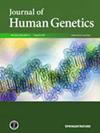Hyaluronidase 2 deficiency due to novel compound heterozygous variants in HYAL2: a case report of siblings with HYAL2 deficiency showing different clinical severity and literature review
IF 2.5
3区 生物学
Q2 GENETICS & HEREDITY
引用次数: 0
Abstract
This study reports the first Asian case of syndromic cleft lip and palate resembling CHARGE-like syndrome, caused by novel compound heterozygous variants of the HYAL2 gene. Hyaluronidase-2 (HYAL2) plays a critical role in hyaluronic acid degradation and tissue remodelling. A 2-year-old Japanese boy presented with growth deficiency, congenital heart disease, craniofacial dysmorphism, micropenis, and developmental delays–features that overlapped with those of CHARGE syndrome. Genetic analysis identified two rare HYAL2 missense variants (c.1133G>A, p.Arg378His; c.1271A>G, p.His424Arg), classified as “likely pathogenic” based on ACMG/AMP criteria. This case highlights the importance of considering HYAL2 deficiency in the syndromic presentation of cleft lip and palate with congenital heart disease, particularly in the absence of CHD7 abnormalities. This study also emphasizes potential primary testicular dysfunction in male patients with HYAL2 deficiency and underscores the need for further research to clarify genotype-phenotype correlations and pathology.HYAL2中新型复合杂合变异体引起的透明质酸酶2缺陷:临床严重程度不同的兄弟姐妹HYAL2缺陷病例报告及文献复习
本研究报告了亚洲首例由HYAL2基因的新型复合杂合变异体引起的类似charge样综合征的综合征型唇腭裂。透明质酸酶-2 (HYAL2)在透明质酸降解和组织重塑中起关键作用。一名2岁的日本男孩表现为生长缺陷、先天性心脏病、颅面畸形、小阴茎和发育迟缓,这些特征与CHARGE综合征重叠。遗传分析鉴定出两个罕见的HYAL2错义变异(c.1133G>A, p.Arg378His;c.1271A >g, p.His424Arg),根据ACMG/AMP标准被分类为“可能致病”。本病例强调了在唇腭裂合并先天性心脏病的综合征表现中考虑HYAL2缺乏的重要性,特别是在没有CHD7异常的情况下。该研究还强调了男性HYAL2缺乏症患者潜在的原发性睾丸功能障碍,并强调需要进一步研究以阐明基因型-表型相关性和病理。
本文章由计算机程序翻译,如有差异,请以英文原文为准。
求助全文
约1分钟内获得全文
求助全文
来源期刊

Journal of Human Genetics
生物-遗传学
CiteScore
7.20
自引率
0.00%
发文量
101
审稿时长
4-8 weeks
期刊介绍:
The Journal of Human Genetics is an international journal publishing articles on human genetics, including medical genetics and human genome analysis. It covers all aspects of human genetics, including molecular genetics, clinical genetics, behavioral genetics, immunogenetics, pharmacogenomics, population genetics, functional genomics, epigenetics, genetic counseling and gene therapy.
Articles on the following areas are especially welcome: genetic factors of monogenic and complex disorders, genome-wide association studies, genetic epidemiology, cancer genetics, personal genomics, genotype-phenotype relationships and genome diversity.
 求助内容:
求助内容: 应助结果提醒方式:
应助结果提醒方式:


